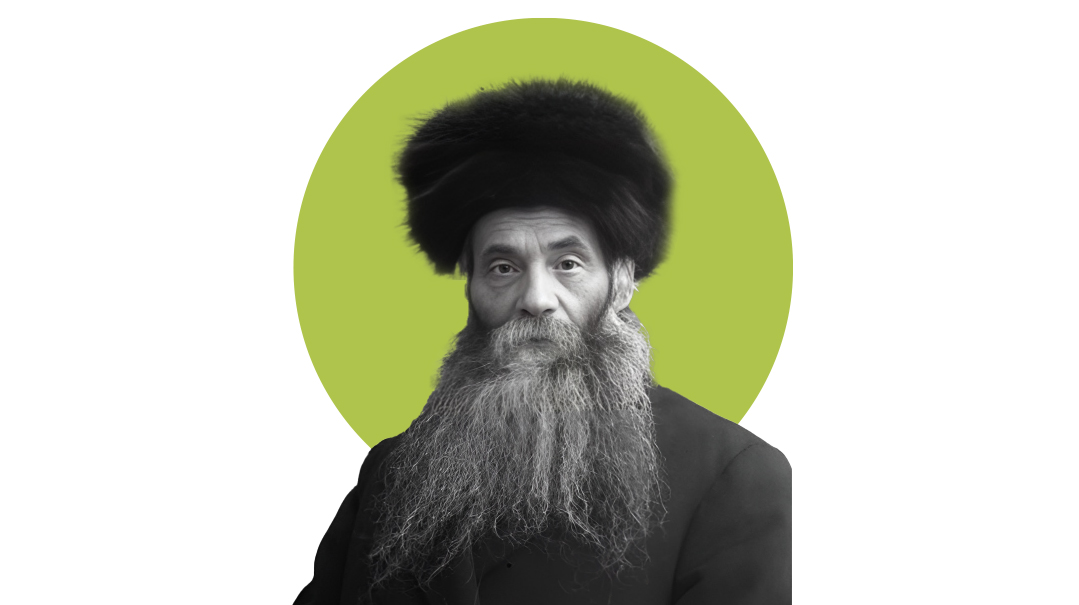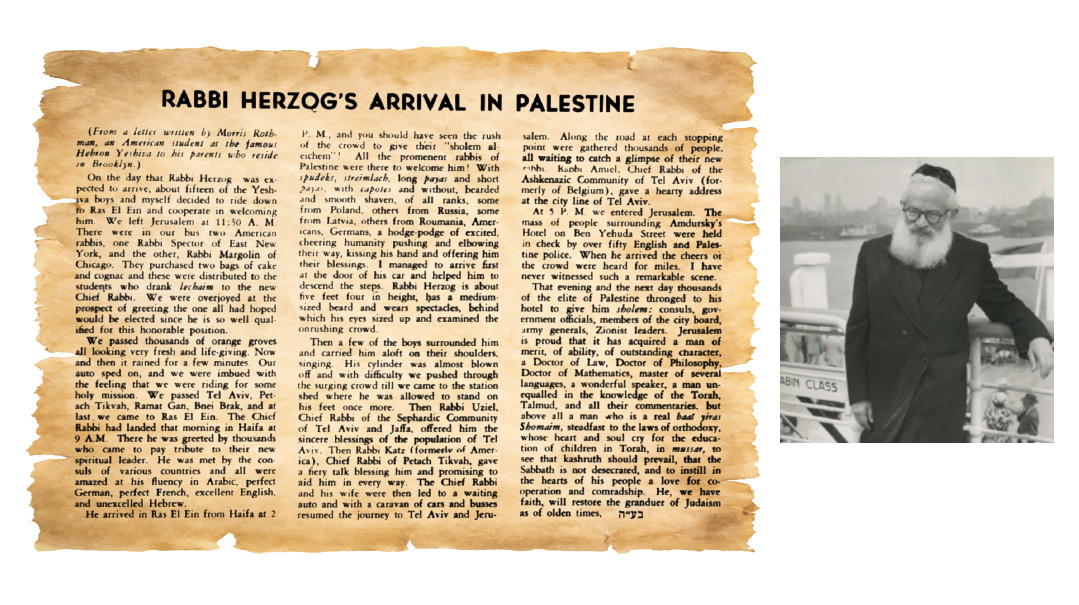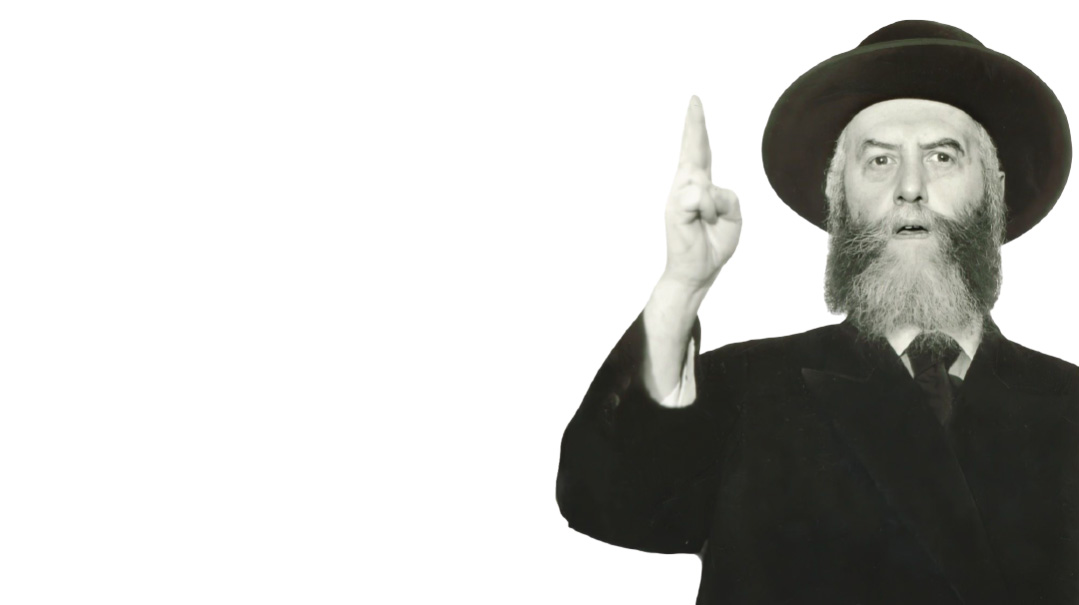Rav Isser Zalman’s Tree of Life
| November 21, 2023Rav Isser Zalman’s legacy of Torah aristocracy, communal leadership, along with his boundless kindness for others, remains with us until this very day

Location: Jerusalem, Israel
Document: Partial list of Eitz Chaim students
Time: 1942
From his formative years in Volozhin and Slabodka through his decades of leadership in Slutzk, to his commanding presence in his later years in Yerushalayim, Rav Isser Zalman Meltzer was one of the greatest architects of Torah of the 20th century. In honor of his 70th yahrtzeit on the 10th of Kislev, we present a glimpse behind the veneer of this noble sage, who guided generations of talmidim at each stage of his storied career. Rav Isser Zalman’s legacy of Torah aristocracy, communal leadership, along with his boundless kindness for others, remains with us until this very day.
In a nondescript apartment across the street from Mir Yerushalayim lived Rav Nota Freund, a tzaddik who graced the Holy City with his presence until his passing in 2013. A group of Mirrer talmidim would customarily attend Shalosh Seudos at his home, where he’d regale them with stories of Yerushalayim of yore. One of his favorite topics was his rebbi muvhak in Yeshivah Eitz Chaim, Rav Isser Zalman Meltzer.
Rav Isser Zalman was renowned for — among other things — his magnum opus Even Ha’ezel. Rav Nota related that the printer found it a challenge to decipher Rav Isser Zalman’s penmanship, so Rebbetzin Baila Hinda would transcribe her husband’s exact words. When the Rebbetzin was busy, Rav Nota would often fill that role himself.
Following his immigration to Yerushalayim in 1925, Rav Isser Zalman settled in the Batei Rand neighborhood at the edge of Nachlaot. Rav Isser Zalman was the quintessential Litvak. Having grown up in Mir, studied in Volozhin, served as rosh yeshivah in Slabodka, then rosh yeshivah and rabbi in Slutzk, he seldom encountered chassidim for the duration of his storied career. Living in the predominantly Galician neighborhood of Batei Rand in his golden years brought the venerated sage an abundance of chassidic neighbors.
Rav Nota shared an anecdote about a time a few weeks prior to Chanukah when Rav Isser Zalman returned from Eitz Chaim to find the door locked because Rebbetzin Baila Hinda wasn’t home. Rav Isser Zalman asked neighbors if he’d be able to sit and wait in their home until the Rebbetzin returned. In the meantime, the host proffered the only sefer in his poverty-stricken Yerushalmi home, Kedushas Levi by Rav Levi Yitzchak of Berditchev. Rav Isser Zalman flipped through to the maamarim expounding upon the holiness of the upcoming holiday.
When the Rebbetzin returned, Rav Isser Zalman thanked his neighbor, handed back the sefer, and that seemed to be the end of the story. A year later, however, this neighbor received a knock at the door. The elderly Litvish rosh yeshivah stood there and asked, “Ken ich hoben yeneh sefer (May I have that sefer)?” Apparently the holy words of Kedushas Levi transcend boundaries.
Rav Nota Freund was part of an elite group sent from Eitz Chaim to help establish Mir Yerushalayim. This act was an expression of twin virtues of Rav Isser Zalman — his nobility of character and his tireless efforts to build Torah. When Rav Leizer Yudel Finkel endeavored to open Mir Yeshivah in Yerushalayim in 1944, it was Rav Isser Zalman who dispatched a group of his finest students from Eitz Chaim — including Rav Nota, Rav Yudel Shapiro, Rav Moshe Shea Landau, Rav Moshe Salant, Rav Chaim Brim, and Rav Mendel Atik — to form the nucleus of the yeshivah. Rav Isser Zalman's act of sacrifice helped build the great edifice that is the Mir today.
Rav Isser Zalman Meltzer was born in the town of Mir in 1870, entering the famed Volozhin yeshivah shortly after his bar mitzvah as one of the youngest students in the yeshivah. Known as Zunya Mirrer, he caught the eye of both the rosh yeshivah, the Netziv, and Rav Chaim Brisker, becoming a close student of both during his seven-year sojourn in Volozhin.
Following his marriage to Baila Hinda Frank, daughter of renowned mussar patron Reb Shraga Feivel Frank of Kovno, Rav Isser Zalman was soon hired by Rav Nosson Tzvi Finkel, the Alter of Slabodka, to serve as the Slabodka rosh yeshivah together with his brother-in-law Rav Moshe Mordechai Epstein in 1894. Three years later, the Alter sent Rav Isser Zalman together with a group of 14 elite Slabodka students commonly known as the “Yad Hachazakah” to Slutzk to help establish a yeshivah there at the behest of Rav Yaakov David Wilowski, the Ridbaz, then serving as rav of Slutzk.
It was an auspicious appointment. At the young age of 27, Rav Isser Zalman assumed responsibility for the new yeshivah, which soon included shouldering its financial burden as well. The Slutzk yeshivah grew in numbers and prestige, and the alumni of its early years included Rav Reuven Katz, Rav Pesach Pruskin, Rav Yosef Eliyahu Henkin, Rav Moshe Feinstein, and Rav Elazar Menachem Shach, among others. With the Ridbaz’s departure in 1903, Rav Isser Zalman was appointed by the Slutzk community to serve as its rav. He served in the dual role of the large Jewish community’s rav and head of the yeshivah for the ensuing two decades. Slutzk was also one of the few yeshivos of Eastern Europe that managed to continue functioning throughout the ravages of World War I without enduring an exile.
With the Bolshevik Revolution and the subsequent establishment of the Soviet Union, the situation of the yeshivah became untenable. The Soviet effort to stamp out religion specifically targeted Torah institutions, and the yeshivah clandestinely crossed the border to Poland in several stages in 1921–22. But it was Rav Isser Zalman’s son-in-law Rav Aharon Kotler who crossed the border and reestablished the yeshivah in Kletzk, Poland. Rav Isser Zalman remained behind with his community, as he felt that was his responsibility to the Jews of Slutzk. Only in 1925, when the situation in the Soviet Union became unbearable, did Rav Isser Zalman finally leave, this time headed to what he presumed to be a quiet retirement in the Land of Israel.
Nothing could have been further from reality. He was immediately hired to serve as rosh yeshivah of Eitz Chaim, raising the caliber of Torah study in this storied Yerushalmi institution to that of its contemporaries in Eastern Europe. Among his students in Eitz Chaim were his own grandson Rav Shneur Kotler, who was in the country during the war years; Rav Shlomo Zalman Auerbach; Rav Yisrael Yaakov Fisher; Rav Avraham Yaakov Zalaznick; Rav Amram Zaks; Rav Chaim Yaakov Goldvicht; Rav Eliezer Waldenberg; Rav Rav Yitzchak Kolitz; and Rav Avraham Shapiro. Ironically, the official name of the Volozhin yeshivah of his youth was Eitz Chaim, the Slutzk yeshivah was also named Eitz Chaim, and he lived out his golden years as rosh yeshivah of Eitz Chaim in Yerushalayim.
In his later years, his public activism emerged on a larger scale. With the establishment of the State of Israel in 1948, the small embattled Torah community faced many challenges in the realms of education, politics, military, and its overall relationship with the government. As one of the last of his generation, a throwback to the greats of Volozhin, Rav Isser Zalman stepped up to serve as the head of the Moetzes Gedolei Hatorah of Agudas Yisrael in Eretz Israel.
He guided it through tumultuous times, which included the initial stages of the Agudah’s participation in the Knesset, the battles over drafting religious girls into the military, and defining the overall parameters of the relationship between religion and state in the nascent State of Israel. He also guided Chinuch Atzmai in its early years and was one of the founders of P’eylim, and he encouraged his students to be active in both endeavors.
In addition to his daughter Chana Perel marrying Rav Aharon Kotler, his daughter Sarah married Rav Yitzchok Meir (Pacziner) Ben-Menachem, who was a rav in Petach Tikvah and served alongside luminaries such as Rav Yosef Shalom Elyashiv and Rav Betzalel Zolty on Israel’s Beth Din Hagadol. His eldest son, Professor Feivel Meltzer, was a noted author and teacher, while his younger son, Rav Tzvi Yehudah was the rav of Pardes Chana (later of Rechovot) and the founder and rosh yeshivah of Yeshivas Kletzk Hadarom, later known simply as “Yeshivat Hadarom.”
Rav Isser Zalman continued to deliver shiurim at Etz Chaim into his eighties. On the last night of his life, he prepared a shiur that he was to deliver the following afternoon, marking the 20th yahrtzeit of his esteemed brother-in-law, Rav Moshe Mordechai Epstein. However, that morning, the 10th of Kislev, November 17, 1953, as he was removing his tefillin after Shacharis, he suffered a fatal heart attack and was niftar. He was 83 years old.
His passing marked the end of an era, in which Volozhin aristocracy, Slutzk leadership, Eitz Chaim and the Moetzes had all come together in one great synthesis that was the great Torah leadership of Rav Isser Zalman Meltzer.
From Even Ha’ezel to Avi Ezri
Rav Elazar Menachem Shach studied in Slutzk and even lived in Rav Isser Zalman’s home, where he was treated like a son. He eventually suggested Rav Shach to his niece Gittel, and following their marriage, he hired him to teach in Slutzk and later in Kletzk. Rav Shach frequently cited Rav Isser Zalman’s Torah insights in his shiurim and contributed to his uncle’s timeless commentary on the Rambam’s Yad Hachazakah, Even Ha’ezel. Rav Isser Zalman encouraged and assisted Rav Shach in the publication of Avi Ezri, somehow securing hard-to-obtain paper during Israel’s 1948 War of Independence.
Why did Rav Isser Zalman Cross the Road?
It was noticed by his Eitz Chaim talmidim that Rav Isser Zalman would take a roundabout route to the yeshivah when he came to deliver his shiur. When questioned why an older man would take a deliberate detour, he mentioned that on his regular route, there were some chickens pecking for morsels of food. He had noticed that the pounding of his cane beating the ground as he approached tended to frighten the chickens away, so he opted to change his route so as not to disturb the chickens’ repast.
Just Love Them
Rav Boruch Mordechai Ezrachi enjoyed relating the following story about Rav Isser Zalman: In the 1950s, one of Rav Isser Zalman’s students, the future Ashkenazi chief rabbi of Yerushalayim, Rav Yitzchok Kolitz (1922–2003), became engaged. Eager to share his joy, he visited Rav Isser Zalman to invite him to his wedding.
However, after learning that the wedding would be in Teveria, Rav Isser Zalman regretfully explained that he couldn’t attend at his advanced age. As a special wedding gift, Rav Isser Zalman presented his student with two volumes of Even Ha’ezel. He inscribed the first volume with warm blessings and high praise.
As Rav Kolitz was leaving, Rav Isser Zalman, realizing an opportunity, called him back. He asked for the second volume and inscribed it as well, writing: “This [sefer] was given as a wedding gift to Rav Yitzchok Kolitz, whose praises have already been written in the first volume.”
Rav Boruch Mordechai explained: “Rav Isser Zalman understood that people don’t expect to see inscriptions in the second volume of a sefer, but he also knew that in a home such as that of Rav Yitzchok Kolitz — where yeshivah students would visit and utilize the seforim — there would be an opportunity to share the high esteem he felt for his student with even more people, even long after he had departed this world.”
Rav Boruch Mordechai used this story to illustrate the profound caring and respect that Rav Isser Zalman had for each and every person he came into contact with.
This Thursday, 10 Kislev, marks the 70th yahrtzeit of Rav Isser Zalman Meltzer
The research of Rabbi Paysach Krohn as well as Eli Neuberger, a prodigious great nephew of Rav Isser Zalman, was utilized in the preparation of this article
(Originally featured in Mishpacha, Issue 987)
Oops! We could not locate your form.






